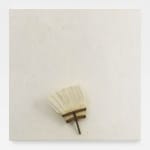


Pier Paolo Calzolari
Untitled #18, 2016
Milk tempera, broom, on canvas
47 1/4 x 47 1/4 x 10 1/4 inches 120 x 120 x 26 cm
PPC.12770
© Pier Paolo Calzolari
Further images
Included in the seminal 1960’s exhibitions curated by Germano Celant, Pier Paolo Calzolari (b. 1943; Bologna, Italy) is associated with “Arte Povera” and is one of the only remaining living...
Included in the seminal 1960’s exhibitions curated by Germano Celant, Pier Paolo Calzolari (b. 1943; Bologna, Italy) is associated with “Arte Povera” and is one of the only remaining living artists from this movement. The artist’s youth was spent in Venice where he was influenced by the city’s particular light and its reflection on the marble of the buildings. These observations lead him to working with frost, one of his most unique and defining materials, which he used to illustrate the perfect white. Like other artists of the “Arte Povera” movement, Calzolari’s materials are elemental and frequently organic: fire, salt, lead, tobacco, moss, burnt wood, oyster shells, tobacco leaves, felt neon, and on occasion butter. While Calzolari may be classified as an installation artist, his practice also includes painting, sculpture and performance. He created “happenings” as early as 1966, drawing viewers into his artwork as performers in what he termed “an activation of space.” Over the subsequent decades Calzolari has continued to experiment, exploring his ongoing interest in light, matter, and time within these media.
Calzolari’s first exhibition at Marianne Boesky Gallery in 2012 was the artist’s first in the United States in over 20 years. Calzolari’s works are included in the collections of the Art Institute of Chicago, Guggenheim Museum, New York, Sammlung Goetz, Munich, Centre Pompidou, Paris, and Palazzo Grassi, Punta della Dogana François Pinault Foundation, Venice, amongst many others. He has been exhibited at the Museum of Modern Art (1985, 2013), Documenta (1992), Galerie Nationale du Jeu de Paume (1994), Venice Biennale (1978, 2007), Ca’ Pesaro, Galleria Internazionale d’Arte Moderna (2011), the Peggy Guggenheim Collection (2011), and the Centre Pompidou (2016). The artist currently lives and works in Lisbon, Portugal.
Calzolari’s first exhibition at Marianne Boesky Gallery in 2012 was the artist’s first in the United States in over 20 years. Calzolari’s works are included in the collections of the Art Institute of Chicago, Guggenheim Museum, New York, Sammlung Goetz, Munich, Centre Pompidou, Paris, and Palazzo Grassi, Punta della Dogana François Pinault Foundation, Venice, amongst many others. He has been exhibited at the Museum of Modern Art (1985, 2013), Documenta (1992), Galerie Nationale du Jeu de Paume (1994), Venice Biennale (1978, 2007), Ca’ Pesaro, Galleria Internazionale d’Arte Moderna (2011), the Peggy Guggenheim Collection (2011), and the Centre Pompidou (2016). The artist currently lives and works in Lisbon, Portugal.



